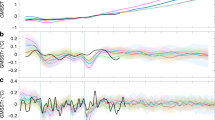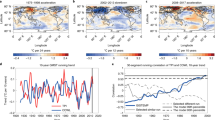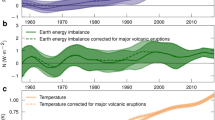Abstract
Despite a steady increase in atmospheric greenhouse gases (GHGs), global-mean surface temperature (T) has shown no discernible warming since about 2000, in sharp contrast to model simulations, which on average project strong warming1,2,3. The recent slowdown in observed surface warming has been attributed to decadal cooling in the tropical Pacific1,4,5, intensifying trade winds5, changes in El Niño activity6,7, increasing volcanic activity8,9,10 and decreasing solar irradiance7. Earlier periods of arrested warming have been observed but received much less attention than the recent period, and their causes are poorly understood. Here we analyse observed and model-simulated global T fields to quantify the contributions of internal climate variability (ICV) to decadal changes in global-mean T since 1920. We show that the Interdecadal Pacific Oscillation (IPO) has been associated with large T anomalies over both ocean and land. Combined with another leading mode of ICV, the IPO explains most of the difference between observed and model-simulated rates of decadal change in global-mean T since 1920, and particularly over the so-called ‘hiatus’ period since about 2000. We conclude that ICV, mainly through the IPO, was largely responsible for the recent slowdown, as well as for earlier slowdowns and accelerations in global-mean T since 1920, with preferred spatial patterns different from those associated with GHG-induced warming or aerosol-induced cooling. Recent history suggests that the IPO could reverse course and lead to accelerated global warming in the coming decades.
This is a preview of subscription content, access via your institution
Access options
Subscribe to this journal
Receive 12 print issues and online access
$209.00 per year
only $17.42 per issue
Buy this article
- Purchase on Springer Link
- Instant access to full article PDF
Prices may be subject to local taxes which are calculated during checkout





Similar content being viewed by others
References
Kosaka, Y. & Xie, S-P. Recent global-warming hiatus tied to equatorial Pacific surface cooling. Nature 501, 403–407 (2013).
Fyfe, J. C., Gillett, N. P. & Zwiers, F. W. Overestimated global warming over the past 20 years. Nature Clim. Change 3, 767–769 (2013).
IPCC Climate Change 2013: The Physical Science Basis (eds Stocker, T. E. et al.) (Cambridge Univ. Press, 2013).
Trenberth, K. E. & Fasullo, J. An apparent hiatus in global warming? Earth’s Future 1, 19–32 (2013).
England, M. et al. Recent intensification of wind-driven circulation in the Pacific and the ongoing warming hiatus. Nature Clim. Change 4, 222–227 (2014).
Kaufmann, R. K., Kauppi, H., Mann, M. L. & Stock, J. H. Reconciling anthropogenic climate change with observed temperature 1998–2008. Proc. Natl Acad. Sci. USA 108, 11790–11793 (2011).
Schmidt, G. A., Shindell, D. T. & Tsigaridis, K. Reconciling warming trends. Nature Geosci. 7, 158–160 (2014).
Solomon, S. et al. The persistently variable ”background” stratospheric aerosol layer and global climate change. Science 333, 866–870 (2011).
Fyfe, J. C., von Salzen, K., Cole, J. N. S., Gillett, N. P. & Vernier, J-P. Surface response to stratospheric aerosol changes in a coupled atmosphere–ocean model. Geophys. Res. Lett. 40, 584–588 (2013).
Santer, B. et al. Volcanic contribution to decadal changes in tropospheric temperature. Nature Geosci. 7, 185–189 (2014).
Zhang, Y., Wallace, J. M. & Battisti, D. S. ENSO-like interdecadal variability: 1900–93. J. Clim. 10, 1004–1020 (1997).
Mantua, N. J., Hare, S. R., Zhang, Y., Wallace, J. M. & Francis, R. C. A Pacific interdecadal climate oscillation with impacts on salmon production. Bull. Am. Meteorol. Soc. 78, 1069–1079 (1997).
Power, S, T., Casey, C., Folland, A., Colman, A & Mehta, V. Interdecadal modulation of the impact of ENSO on Australia. Clim. Dynam. 15, 319–324 (1999).
Deser, C, Phillips, A. S. & Hurrell, J. W. Pacific interdecadal climate variability: Linkages between the tropics and the North Pacific during boreal winter since 1900. J. Clim. 17, 3109–3124 (2004).
Dai, A. The influence of the Inter-decadal Pacific Oscillation on US precipitation during 1923–2010. Clim. Dynam. 41, 633–646 (2013).
Meehl, G. A., Arblaster, J. M., Fasullo, J. T., Hu, A. & Trenberth, K. E. Model-based evidence of deep-ocean heat uptake during surface-temperature hiatus periods. Nature Clim. Change 1, 360–364 (2011).
Meehl, G. A., Hu, A., Arblaster, J., Fasullo, J. T. & Trenberth, K. E. Externally forced and internally generated decadal climate variability in the Pacific. J. Clim. 26, 7298–7310 (2013).
Seager, R., Harnik, N., Kushnir, Y., Robinson, W. & Miller, J. Mechanisms of hemispherically symmetric climate variability. J. Clim. 16, 2960–2978 (2003).
Trenberth, K. E., Caron, J. M., Stepaniak, D. P. & Worley, S. Evolution of El Niño–Southern Oscillation and global atmospheric surface temperatures. J. Geophys. Res. 107, 4065 (2002).
Balmaseda, M. A., Trenberth, K. E. & Källén, E. Distinctive climate signals in reanalysis of global ocean heat content. Geophys. Res. Lett. 40, 1754–1759 (2013).
Neelin, J. D. Climate Change and Climate Modeling (Cambridge Univ. Press, 2011).
DelSole, T., Tippett, M. K. & Shukla, J. A significant component of unforced multidecadal variability in twentieth century global warming. J. Clim. 24, 909–926 (2011).
Wu, Z., Huang, N. E., Wallace, J. M., Smoliak, B. V. & Chen, X. On the time-varying trend in global-mean surface temperature. Clim. Dynam. 37, 759–773 (2011).
Liu, Z. Y. Dynamics of interdecadal climate variability: A historical perspective. J. Clim. 25, 1963–1995 (2012).
Chen, J., Del Genio, A. D., Carlson, B. E. & Bosilovich, M. G. The spatiotemporal structure of twentieth-century climate variations in observations and reanalyses. Part II: Pacific pan-decadal variability. J. Clim. 21, 2634–2650 (2008).
Hansen, J., Ruedy, R., Sato, M. & Lo, K. Global surface temperature change. Rev. Geophys. 48, RG4004 (2010).
Morice, C. P., Kennedy, J. J., Rayner, N. A. & Jones, P. D. Quantifying uncertainties in global and regional temperature change using an ensemble of observational estimates: The HadCRUT4 dataset. J. Geophys. Res. 117, D08101 (2012).
Barnston, A. G. & Livezey, R. E. Classification, seasonality and persistence of low-frequency atmospheric circulation patterns. Mon. Wealth. Rev. 115, 1083–1126 (1987).
Kay, J. E. et al. The Community Earth System Model (CESM) large ensemble project: A community resource for studying climate change in the presence of internal climate variability. Bull. Am. Meteorol. Soc. http://dx.doi.org/10.1175/BAMS-D-13-00255.1 (2014)
Taylor, K. E., Stouffer, R. J. & Meehl, G. A. An overview of CMIP5 and the experiment design. Bull. Am. Meteorol. Soc. 93, 485–498 (2012).
Santer, B. et al. Identifying human influences on atmospheric temperature. Proc. Natl Acad. Sci. USA 110, 26–33 (2013).
Lanzante, J. R. Resistant, robust and non-parametric techniques for the analysis of climate data: Theory and examples, including applications to historical radiosonde station data. Int. J. Climatol. 16, 1197–1226 (1996).
Acknowledgements
We thank K. Trenberth, B. Merryfield and G. Boer for constructive comments, P. Kushner for sharing the CCSM4 ensemble simulations used in Supplementary Fig. 10, and H. Wang for providing the data used in Supplementary Fig. 1b. We acknowledge the CMIP5 modeling groups and NCAR CESM large ensemble project, the Program for Climate Model Diagnosis and Intercomparison and the WCRP’s Working Group on Coupled Modelling for their roles in making available the WCRP CMIP multi-model data sets. Support for this data set is provided by the Office of Science, US Department of Energy. A.D. is supported by the National Science Foundation (AGS-1353740) and the US Department of Energy’s Office of Science (DE-SC0012602); S-P.X. is supported by the NSF (AGS- 1305719).
Author information
Authors and Affiliations
Contributions
A.D. designed the study, performed all the calculations, made most of the figures, and wrote the draft of the paper; J.C.F. helped improve the manuscript and made Supplementary Fig. 10; S-P.X. helped improve the manuscript; X.D. helped initiate the study.
Corresponding author
Ethics declarations
Competing interests
The authors declare no competing financial interests.
Supplementary information
Rights and permissions
About this article
Cite this article
Dai, A., Fyfe, J., Xie, SP. et al. Decadal modulation of global surface temperature by internal climate variability. Nature Clim Change 5, 555–559 (2015). https://doi.org/10.1038/nclimate2605
Received:
Accepted:
Published:
Issue Date:
DOI: https://doi.org/10.1038/nclimate2605
This article is cited by
-
The significant influence of the Atlantic multidecadal variability to the abrupt warming in Northeast Asia in the 1990s
npj Climate and Atmospheric Science (2024)
-
Contributions of external forcing and internal variability to the multidecadal warming rate of East Asia in the present and future climate
npj Climate and Atmospheric Science (2024)
-
Impacts of natural and anthropogenic forcings on historical and future changes in global-land surface air temperature in CMIP6–DAMIP simulations
Climatic Change (2024)
-
Record-breaking High-temperature Outlook for 2023: An Assessment Based on the China Global Merged Temperature (CMST) Dataset
Advances in Atmospheric Sciences (2024)
-
Recent increase in rapid intensification events of tropical cyclones along China coast
Climate Dynamics (2024)



